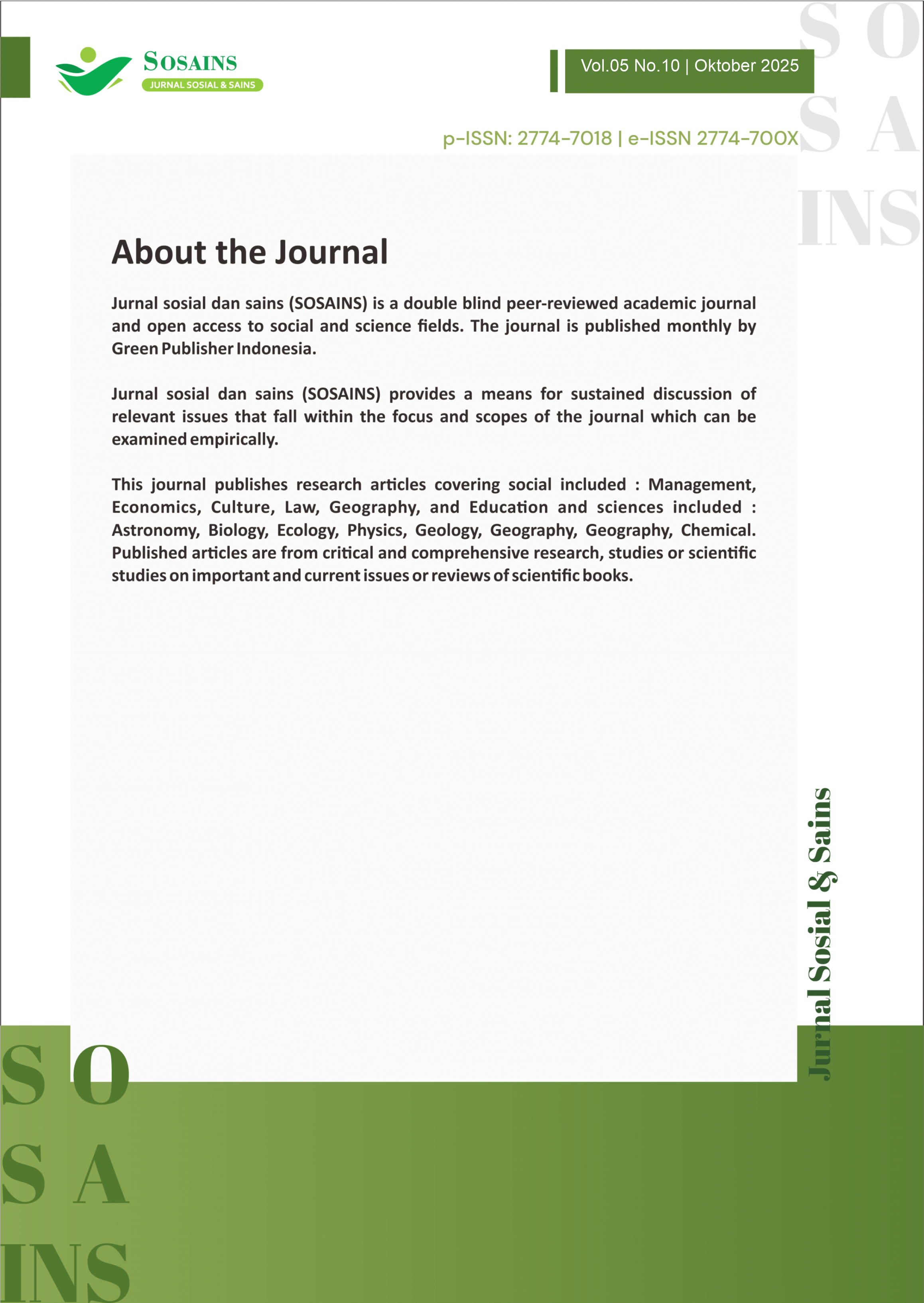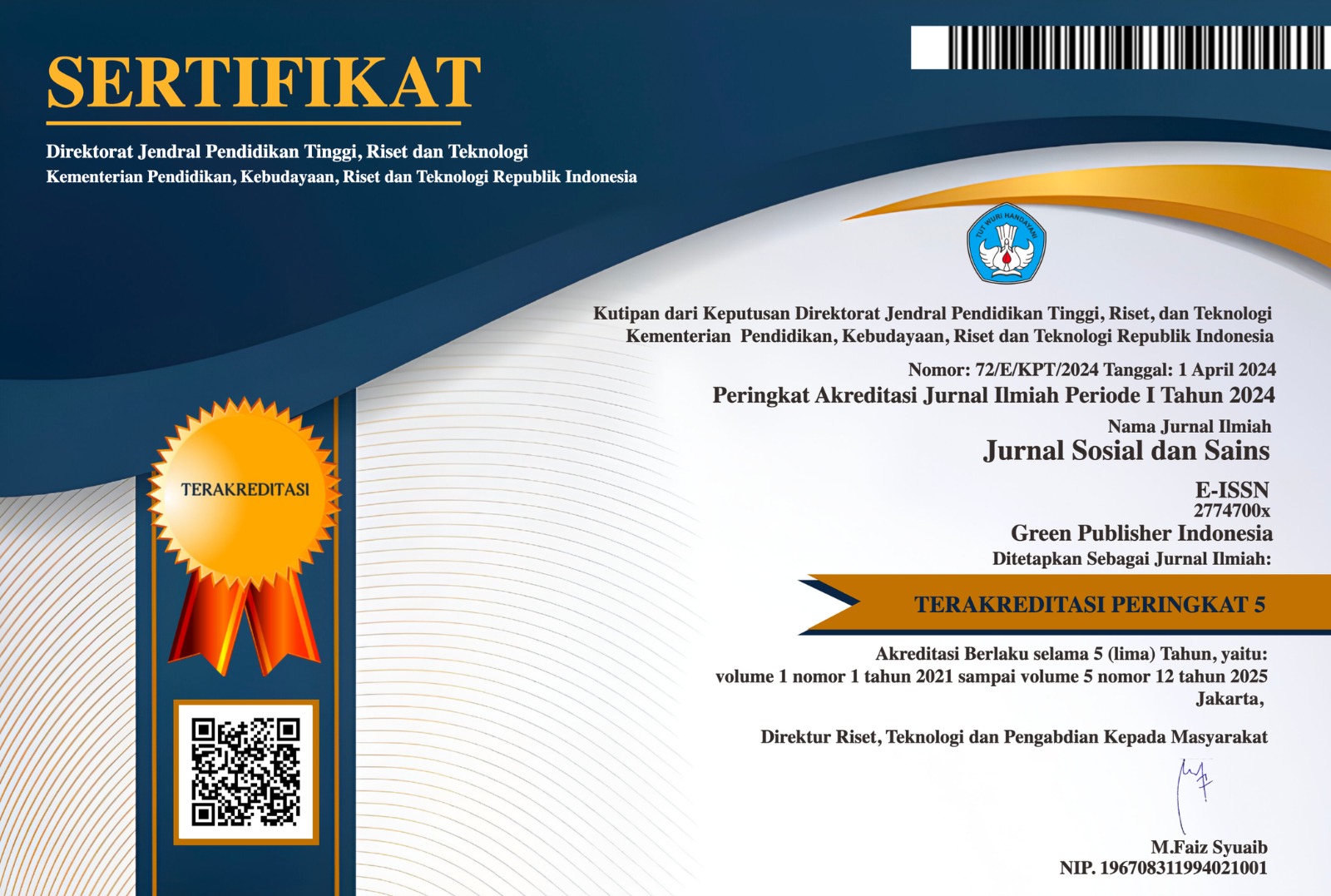Analysis of the Impact of Fiscal Incentives on the Development of Electric Vehicles in Indonesia's Green Economy Transition (2020-2024)
DOI:
https://doi.org/10.59188/jurnalsosains.v5i10.32563Keywords:
Climate change, Green economy, Fiscal incentives, Electric vehiclesAbstract
Accelerating the transition to a green economy is the main demand for developing countries such as Indonesia amid the increasing impact of climate change. This study analyzes the effectiveness of fiscal incentive policies regulated in Presidential Regulation No. 79 of 2023 on increasing the use of battery-based electric vehicles as part of the national clean energy strategy. The study was conducted using a quantitative descriptive approach with secondary data from the Central Statistics Agency, the Ministry of Energy and Mineral Resources, and the 2021–2030 Rencana Usaha Penyediaan Tenaga Listrik (RUPTL). The (PCA) method is used to assess sectoral contributions to variations in carbon emissions, while the ANOVA test is applied to identify significant differences between years. The results of the analysis show that there is a surge in the adoption of electric vehicles after the policy is implemented, but CO₂ emissions still fluctuate highly, especially in the industrial and electricity sectors. The highest score of the first key component (PC1) in 2021 indicates a pivotal point in the changing sectoral dynamics towards green transformation, but the misalignment in the following years highlights the need for cross-policy integration. Thus, the effectiveness of fiscal incentives is not enough to rely solely on the demand for electric vehicles but also requires energy system reform and the readiness of economic structures to adopt low-emission technologies.
References
Alfathi, B. (2025). 85% listrik Indonesia berasal dari energi fosil. GoodStats Data. https://data.goodstats.id/statistic/85-listrik-indonesia-berasal-dari-energi-fosil-g1Bb8
Ayuningsih, A. N., Oktaviani, M. A., Chandra, A., Athyah, N., Manda, M. P. D., Citra, Z., & Sulaiman, S. D. (2023). Ratifikasi Paris Agreement dan pengaplikasian National Determined Contribution (NDC) Indonesia. Jurnal Ilmu Sosial dan Ilmu Politik Unja, 7(1), 45-58. https://doi.org/10.22437/jisipunja.v7i1.21859
Field, A. (2017). Discovering statistics using IBM SPSS Statistics (5th ed.). SAGE Publications.
Figenbaum, E. (2017). Perspectives on Norway's supercharged electric vehicle policy. Environmental Innovation and Societal Transitions, 25, 14–34. https://doi.org/10.1016/j.eist.2016.11.002
Hardman, S., Jenn, A., Tal, G., Axsen, J., Beard, G., Daina, N., Figenbaum, E., Jakobsson, N., Jochem, P., Kinnear, N., Plötz, P., Pontes, J., Refa, N., Sprei, F., Turrentine, T., & Witkamp, B. (2018). A review of consumer preferences of and interactions with electric vehicle charging infrastructure. Transportation Research Part D: Transport and Environment, 62, 508-523. https://doi.org/10.1016/j.trd.2018.04.002
Hasan, K., & Hummer, L. (2024, November 8). Indonesia's captive coal on the uptick. CREA & GEM. https://energyandcleanair.org/wp/wp-content/uploads/2024/11/EN-CREA_GEM_Indonesia-Captive_2024.pdf
IPCC. (2021). Climate Change 2021: The Physical Science Basis. Contribution of Working Group I to the Sixth Assessment Report of the Intergovernmental Panel on Climate Change. Cambridge University Press. https://doi.org/10.1017/9781009157896
Kabir, M., Habiba, U. E., Khan, W., Shah, A., Rahim, S., Rios-Escalante, P. R. D. los, Farooqi, Z.-U.-R., Ali, L., & Shafiq, M. (2023). Climate change due to increasing concentration of carbon dioxide and its impacts on environment in 21st century; a mini review. Journal of King Saud University - Science, 35(5), 102693. https://doi.org/10.1016/j.jksus.2023.102693
Langbroek, J. H. M., Franklin, J. P., & Susilo, Y. O. (2016). The effect of policy incentives on electric vehicle adoption. Energy Policy, 94, 94-103. https://doi.org/10.1016/j.enpol.2016.03.050
Liu, Z., Ciais, P., Deng, Z., Lei, R., Davis, S. J., Feng, S., Zheng, B., Cui, D., Dou, X., Zhu, B., Guo, R., Ke, P., Sun, T., Lu, C., He, P., Wang, Y., Yue, X., Wang, Y., Lei, Y., ... Schellnhuber, H. J. (2020). Near-real-time monitoring of global CO2 emissions reveals the effects of the COVID-19 pandemic. Nature Communications, 11(1), 5172. https://doi.org/10.1038/s41467-020-18922-7
Lutsey, N., & Nicholas, M. (2019). Update on electric vehicle costs in the United States through 2030. International Council on Clean Transportation. https://theicct.org/publication/update-on-electric-vehicle-costs-in-the-united-states-through-2030/
Michalek, J. J., Chester, M., Jaramillo, P., Samaras, C., Shiau, C. S. N., & Lave, L. B. (2011). Valuation of plug-in vehicle life-cycle air emissions and oil displacement benefits. Proceedings of the National Academy of Sciences, 108(40), 16554-16558. https://doi.org/10.1073/pnas.1104473108
PLN. (2022). Laporan tahunan 2022. PT Perusahaan Listrik Negara.
Santika, W. G., Urmee, T., Simsek, Y., Bahri, P. A., & Pryor, T. (2020). An assessment of energy policy impacts on achieving Sustainable Development Goal 7 in Indonesia. Energy for Sustainable Development, 59, 33-48. https://doi.org/10.1016/j.esd.2020.08.006
Shlens, J. (2014). A tutorial on principal component analysis. arXiv:1404.1100. https://arxiv.org/pdf/1404.1100
Sovacool, B. K., & Drupady, I. M. (2016). Energy access, poverty, and development: The governance of small-scale renewable energy in developing Asia. Routledge. https://doi.org/10.4324/9781315577326
Sugiyono. (2013). Metode penelitian pendidikan: Pendekatan kuantitatif, kualitatif dan R&D. Alfabeta.
Taefi, T. T., Kreutzberger, E., Hesse, H., Held, T., & Fink, A. (2016). Supporting the adoption of electric vehicles in urban road freight transport – A multi-criteria analysis of policy measures in Germany. Transportation Research Part A: Policy and Practice, 91, 61-79. https://doi.org/10.1016/j.tra.2016.06.003
UNFCCC. (2020). The Paris Agreement. UNFCCC. Retrieved September 23, 2025, from https://unfccc.int/process-and-meetings/the-paris-agreement
Zhang, X., Bai, X., & Shang, J. (2018). Is subsidized electric vehicles adoption sustainable: Consumers' perspectives and policy implications. Journal of Cleaner Production, 192, 71-79. https://doi.org/10.1016/j.jclepro.2018.04.252
Downloads
Published
How to Cite
Issue
Section
License
Copyright (c) 2025 Dyah Hanum Puspita, Salsabila Raisha Meshanayagi, Faiz Fadhlirobby, Revaya Rizqia Pasya, Elyana Ade Pertiwi

This work is licensed under a Creative Commons Attribution-ShareAlike 4.0 International License.
Authors who publish with this journal agree to the following terms:
- Authors retain copyright and grant the journal right of first publication with the work simultaneously licensed under a Creative Commons Attribution-ShareAlike 4.0 International (CC-BY-SA). that allows others to share the work with an acknowledgement of the work's authorship and initial publication in this journal.
- Authors are able to enter into separate, additional contractual arrangements for the non-exclusive distribution of the journal's published version of the work (e.g., post it to an institutional repository or publish it in a book), with an acknowledgement of its initial publication in this journal.
- Authors are permitted and encouraged to post their work online (e.g., in institutional repositories or on their website) prior to and during the submission process, as it can lead to productive exchanges, as well as earlier and greater citation of published work.








